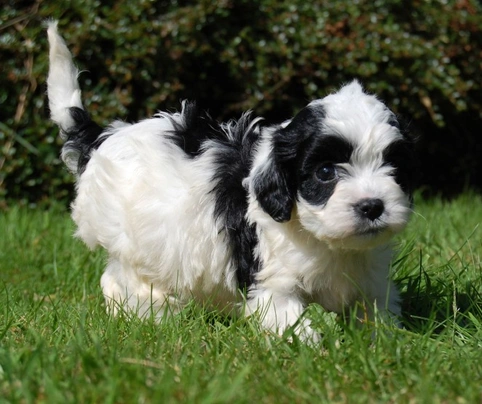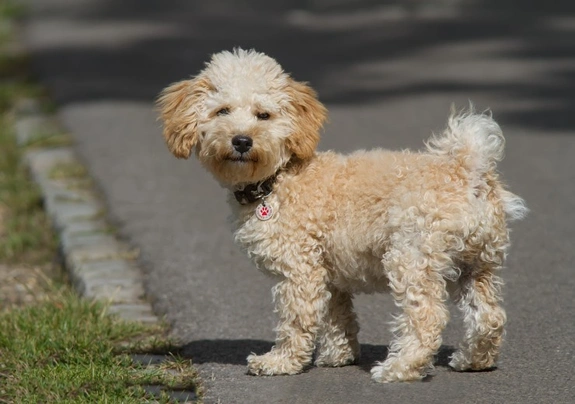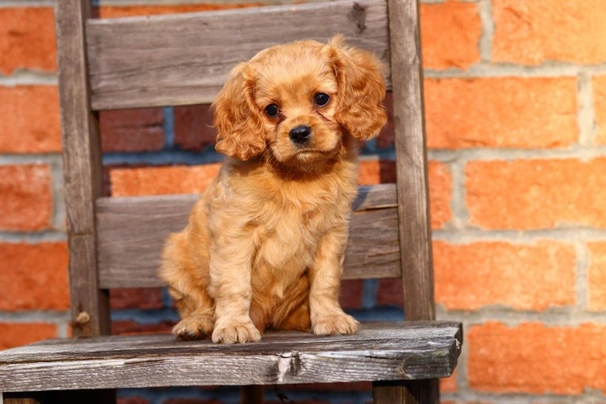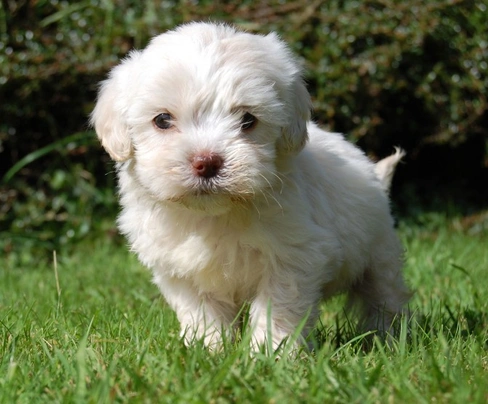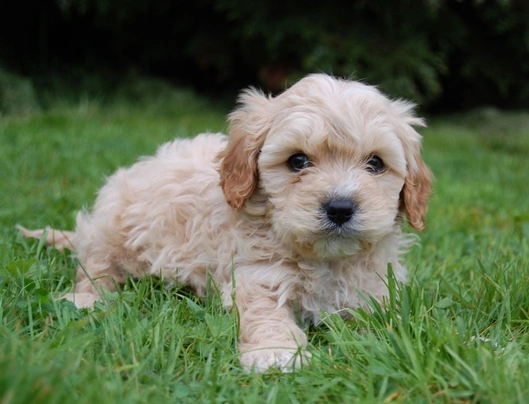Cavapoo
Pros
Cons
Introduction of the Cavapoo
The Cavapoo is a delightful hybrid dog, crossbred from the Poodle and the Cavalier King Charles Spaniel, prized for their affectionate nature, intelligence, and relatively low shedding coats. Emerging first in the 1950s in America, the Cavapoo is now a highly favoured companion across the UK, admired for combining the gentle charm of the Cavalier with the hypoallergenic qualities of the Poodle. These dogs typically possess a soft, expressive face coupled with large, soulful eyes, making them visually endearing as well as emotionally engaging.
Perfect For
Cavapoos make excellent pets for first-time owners who appreciate a loving, sociable dog eager to please. Their adaptable nature suits both apartment living and homes with gardens, provided they receive ample daily exercise and mental stimulation. Families with older children will find the Cavapoo patient and gentle, while singles or retirees may delight in their devoted companionship and alert nature. Given their intelligence and friendly temperament, they also thrive in homes where ongoing obedience training and interaction are priorities.
Key Considerations
Potential owners should note that Cavapoos dislike extended periods of solitude and are prone to separation anxiety if left alone too long, which may lead to behavioural problems such as barking or destructive chewing. Because the breed is relatively new and hybrid in origin, there is variability in size, coat type, and temperament between individuals. Grooming is also a commitment; their coats require regular attention to prevent matting, especially for those leaning towards the curlier Poodle coat. Responsible ownership demands commitment to regular vet checks due to possible inherited health issues from both parent breeds, including heart and eye concerns.
History of the Cavapoo
The Cavapoo originated in the United States in the 1950s as an intentional cross aiming to combine the intelligence and low-shedding coat of the Poodle with the friendly disposition of the Cavalier King Charles Spaniel. Early breeders sought to produce a low-allergen dog suited to companion roles for allergy sufferers, merging style with function.
Early Development
Initial breeding programmes focused on using Miniature Poodles crossed with Cavaliers to reduce health risks associated with Toy Poodles, known for more hereditary ailments. The collaborative breeding groundwork was laid primarily by American and Australian enthusiasts, gradually spreading to the UK. Unlike established breeds, the Cavapoo has no fixed breed standard, reflecting its crossbreed origins and resulting in varied appearances and temperaments.
Modern Recognition
Despite the breed's popularity globally, the Cavapoo lacks official recognition by The Kennel Club in the UK or major international canine registries. Nonetheless, its following continues to grow, with breeder clubs and enthusiasts working towards consistent breeding practices. Its status remains that of a designer or hybrid dog, with hopes that selective breeding might achieve standardisation over successive generations. Today, Cavapoos are a highly sought companion dog, celebrated for their versatility, loving nature, and appeal to allergy sufferers.
Appearance of the Cavapoo
Size and Build
Cavapoos are small to medium-sized dogs typically standing between 33 cm to 45 cm tall at the withers for both males and females, weighing approximately 5 to 10 kg. They tend to have a compact, balanced build with a slightly rounded skull and a moderate muzzle, reflecting traits inherited variably from their Poodle and Cavalier parents. Their bodies are well-proportioned with agile, muscular limbs suited for spirited play and comfortable companionship.
Coat and Colours
The breed’s coat varies widely, ranging from silky, straight hair reminiscent of the Cavalier King Charles Spaniel, to a soft, wavy or curly texture closer to the Poodle's. Their fur is considered low shedding, often appealing to those with mild allergies, though dander being shed remains a consideration. Common colours include black, white, chestnut, gold, Blenheim (chestnut and white), and tricolour (black, white, tan). These colours may appear in various patterns and combinations, enhancing the distinctiveness of each dog.
Distinctive Features
Characteristic features include expressive, large eyes and floppy ears covered with soft fur. Their tail carriage is lively, often wagging with enthusiasm, complementing a bouncy and positive gait that reflects their energetic yet gentle personality. Many Cavapoos inherit the elegant high-stepping gait of the Poodle, reinforcing their playful and engaging appearance.
Gender Differences
While males and females are similar in height and weight, males may sometimes be slightly larger and more robust. Temperamentally, there are few marked differences, though females may display marginally higher sensitivity and cuddliness. Both sexes are equally trainable and affectionate, suiting family environments well.
Since Cavapoos are a crossbreed, there is no formal breed standard, but reputable breeders strive to maintain health, temperament, and desirable physical traits without exaggeration.
Temperament of the Cavapoo
The Cavapoo’s temperament is renowned for loving affection, friendliness, and adaptability, traits inherited from their Poodle and Cavalier parents. They make devoted family companions, bonding deeply with all household members and craving close involvement in daily activities. Their gentle disposition generally makes them excellent with children and other pets when properly socialised from a young age.
These dogs have an innate intelligence and sensitivity; they respond best to patient, positive training and are known to be particularly eager to please. However, they can develop separation anxiety if left isolated for extended periods, leading to barking and destructive behaviours as a manifestation of stress. Early socialisation and mental stimulation are essential to prevent such issues.
Cavapoos typically exhibit low to moderate prey drive, although owners should supervise interactions with small pets or wildlife. Their playful and energetic nature suits canine sports and interactive games, boosting their mental and physical wellbeing.
Though not loud dogs by nature, Cavapoos will alert owners to strangers or unusual activity, making them effective watchdogs without excessive barking. Their sensitive nature means harsh correction can have negative effects; consistency in gentle reinforcement builds a confident, well-adjusted companion.
Intelligence / Trainability of the Cavapoo
Thanks to their parentage, Cavapoos are intelligent and trainable, responding well to early and consistent training approaches that are positive and reward-based. Training should ideally begin as soon as the puppy arrives home, focusing initially on socialisation and basic obedience.
Puppy Training Priorities
During the first six months, emphasis should be placed on house training, social exposure to people and other animals, and teaching fundamental commands such as sit, come, and stay. Puppy classes around 10 to 12 weeks old greatly benefit confidence and social skills.
Training Methods That Work
Gentle positive reinforcement using treats and praise works best with Cavapoos, while harsh methods can damage their sensitive temperament. Short, engaging sessions keep their attention and build enthusiasm for learning.
Advanced Training Potential
Fully grown Cavapoos can excel in obedience trials, agility, therapy dog roles, and other canine sports. Their intelligence and willingness make them especially suited for training beyond basic commands.
Common Training Mistakes
Owners sometimes expect rapid house training; patience is key as Cavapoos may take longer to reliably toilet train. Overuse of punishment or inconsistency in commands can confuse and stress the dog, highlighting the value of a calm, structured approach.
Children and other
Cavapoos are especially suited to families with older children who understand how to interact gently with small dogs, making them patient and affectionate companions for youngsters. Supervised introductions and respectful play are essential to ensure positive experiences for both dog and child.
While Cavapoos generally tolerate other pets well, their small size means they may be vulnerable to overly boisterous toddlers or very young children who may unintentionally frighten or overwhelm them. Careful supervision during interactions is vital, as Cavapoos can become anxious or scared if they feel threatened.
Teaching children to respect the dog’s personal space, approach slowly, and avoid grabbing or rough handling are important steps in fostering harmony. Safe environments with quiet resting areas for the dog help reduce stress and prevent accidental incidents.
Owners should be mindful of the breed’s energy and social needs, ensuring that both children and dogs receive gentle supervision and structured interaction to build mutual trust and affection.
Health of the Cavapoo
The Cavapoo enjoys an average lifespan of around 13 to 15 years when given proper nutrition, exercise, and veterinary care. Despite the hybrid vigour generally associated with crossbreeds, Cavapoos may inherit health issues typical of their parent breeds, which responsible breeders monitor carefully.
Breed-Specific Health Conditions
Known health issues may include syringomyelia, particularly affecting the Cavalier lineage, mitral valve disease, hereditary cataracts, hip dysplasia, luxating patella, progressive retinal atrophy, and various autoimmune and neurological conditions. Awareness and screening can mitigate risks to breeding and ownership.
Genetic Testing Requirements
Breeders should ensure Miniature Poodles and Cavaliers used in breeding are tested for specific genetic disorders including prcd-PRA, Von Willebrand’s disease, hip scoring, and MRI scanning for syringomyelia where applicable. These tests are crucial to reduce incidence of inherited conditions in litters.
Preventive Healthcare Schedule
Routine veterinary visits with vaccinations starting at 10-12 weeks, followed by boosters, parasite prevention, dental checks, and annual health screenings form standard preventive care. Spaying/neutering at six months is recommended unless breeding intentions are present.
Insurance Considerations
Cavapoos frequently incur claims related to hereditary heart disease, eye conditions, and allergies. Choosing comprehensive pet insurance plans that cover hereditary conditions and have reasonable excess rates is beneficial for long-term peace of mind.
Caring for the Cavapoo
Caring for a Cavapoo requires daily attention to grooming, exercise, nutrition, and mental well-being. Their coat needs regular brushing to prevent mats and tangles, with professional grooming advisable every 4 to 6 weeks. Exercise should balance stamina and joint care, especially in puppies and seniors.
Daily Care Routine
A typical day might begin with a short morning walk, followed by playtime and mental activities. Afternoons benefit from a longer walk or active play in a secure garden. Feeding should follow scheduled times with monitored portion sizes. Evening grooming and quiet rest time help sustain a healthy routine.
Living Environment Needs
Cavapoos adapt well to flats or houses but require a safe, quiet space for sleep and solitude. Secure fencing is important in gardens to prevent escape. Due to their short muzzles, they are sensitive to heat and moisture, so temperature regulation is critical in warmer months.
Seasonal Care Adjustments
During summer, shade and frequent water access are essential to prevent overheating. In winter, coat protection and warm bedding support health and comfort. Attention to skin and coat conditions is necessary year-round.
Senior Care Adaptations
Older Cavapoos may need mobility aids, joint supplements, and gentler exercise. Adjusting diet for age-related metabolism changes and providing soft bedding are also important to maintain comfort and quality of life.
Grooming of the Cavapoo
The grooming demands of a Cavapoo vary greatly depending on coat type but generally require consistent maintenance due to their curly or wavy fur. Daily or every-other-day brushing helps prevent mats and tangles, while professional grooming every 4 to 6 weeks is recommended to keep their coat manageable and healthy.
Coat Maintenance Schedule
Daily brushing sessions of 10-15 minutes help maintain coat health. Weekly comb-throughs with a metal comb can catch early tangles. Regular cleaning of tear stains, ear canals, and sensitive areas helps prevent infections and skin issues.
Professional Grooming Requirements
Professional groomers often provide clipping, trimming around sanitary areas, and styling. Costs typically range between £40-£70 per session. Scheduling appointments every 4 to 6 weeks ensures the coat remains in good condition.
Home Grooming Techniques
Owners should use slicker brushes, pin brushes, metal combs, and detanglers for regular home grooming. Nail clipping and ear cleaning should also be routine. Attention to dental hygiene is essential given the breed's susceptibility to plaque accumulation.
Common Grooming Challenges
Mats often form behind ears, under the legs, and around the belly if brushing is neglected. Tear staining is frequent and requires gentle and regular cleaning. Owners should be vigilant for skin redness or irritation caused by trapped moisture or dirt, especially in folds.
Exercise of the Cavapoo
Cavapoos are lively and intelligent dogs requiring a combination of physical exercise and mental stimulation to thrive. Typically, they need two walks a day: a shorter, gentle walk in the morning and a longer, engaging walk in the afternoon with opportunities for exploration and play.
Daily Exercise Requirements
Adults usually require 60 to 90 minutes of activity daily, adjusted for age and health. Puppies need controlled exercise to protect growing joints and should avoid excessive jumping or stair climbing.
Suitable Activities
These dogs excel in agility, obedience training, and interactive games like fetch. Providing puzzle toys and frequent training sessions support their high intelligence and prevent boredom. Swimming may appeal to some, but individual preferences vary.
Exercise Restrictions
Puppies should not overexert themselves with strenuous activities until fully grown. Joint health must be protected through moderate, balanced exercise. Hot weather requires caution to prevent overheating due to the breed’s shorter muzzle.
Mental Stimulation Ideas
Interactive toys, scent games, and obedience challenges engage the Cavapoo’s mind. Training sessions that incorporate new commands or tricks maintain enthusiasm. A weekly routine balancing physical and mental activities best supports their wellbeing.
Feeding of the Cavapoo
Nutrition for Cavapoos should be tailored to their life stage, size, and activity level, focusing on high-quality balanced diets supporting their energetic and affectionate nature.
Nutritional Requirements
Puppies require protein-rich diets to aid growth, with appropriate fats and nutrients for immune and neurological development. Adult dogs need balanced protein and fat ratios to maintain healthy body condition and energy.
Feeding Schedule Guidelines
Frequent small meals are preferred during puppyhood, transitioning to two meals per day for adults. Portion sizes must be monitored to prevent obesity, a common risk for small dogs.
Special Dietary Considerations
Some Cavapoos may have food sensitivities or allergies; gradual diet changes and veterinary consultations are recommended. Supplements like omega-3s aid coat and skin health.
Weight Management
Maintaining an ideal body condition score through controlled feeding and regular exercise is crucial. Owners should be vigilant to avoid overfeeding and excessive treats that contribute to weight gain.
Cavapoo price
Purchasing a Cavapoo puppy in the UK typically ranges between £1,000 and £1,900 when buying from a licensed or reputable individual breeder, reflecting the breed’s high demand and care in breeding. Prices may vary depending on coat type, breeder reputation, location, and whether the puppy is bred for companionship or show potential.
Initial set-up costs for a Cavapoo include quality supplies such as a crate, playpen, bedding, grooming tools, collars, leads, and toys, estimated between £200 and £400. Puppy vaccinations and neutering/spaying fees add further initial expenses.
Ongoing monthly expenses can range between £50 and £80, covering premium quality food, regular grooming visits, routine veterinary care such as vaccinations and parasite prevention, plus pet insurance premiums which vary depending on coverage chosen.
Over a lifetime, owners should anticipate veterinary costs, insurance, grooming, diet, and incidental expenses summing to several thousand pounds. Planning for health insurance is especially prudent given the breed's inherited risks.
You can find Cavapoo for sale on Pets4Homes to explore current market availability and prices.
Buying advice
Purchasing a Cavapoo requires caution due to the breed's popularity and the presence of unscrupulous breeders. One should always prioritise purchasing from responsible breeders who prioritise health, temperament, and ethical breeding practices. You can find Cavapoo for sale on Pets4Homes, offering reputable breeders and current listings.
Finding Ethical Breeders
Look for breeders with transparent breeding records, health testing certificates for both parents, and evidence of socialisation from birth. Visiting breeding facilities and meeting both puppies and parents is important before purchase.
Health Testing Verification
Ensure breeders genetically test for inherited conditions such as prcd-PRA, Von Willebrand’s disease, hip scoring, syringomyelia scans for females, and annual heart health checks to mitigate risks associated with Cavaliers and Poodles.
Puppy Selection Process
Temperament tests and health assessments should be conducted at the breeder level. Choosing a puppy with a calm, curious disposition and no signs of distress is ideal. Inspecting eyes, coat, and overall vitality is recommended.
Contract and Guarantee Review
A detailed contract including health guarantees, return policies, and microchipping assurances protects the buyer. Avoid sellers unwilling to offer such assurances.
Rescue and Adoption Options
Prospective owners may consider adopting from Cavapoo or designer dog rescues that offer responsible rehoming services, often with health and temperament assessments already completed.
